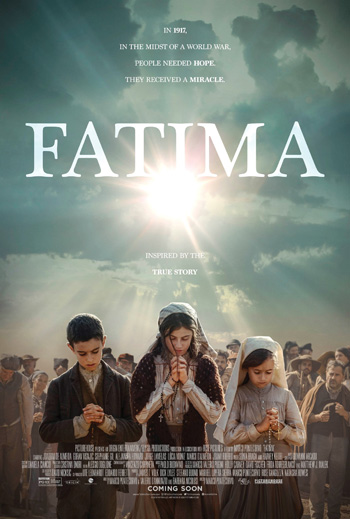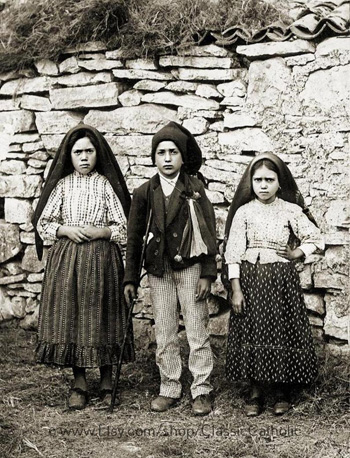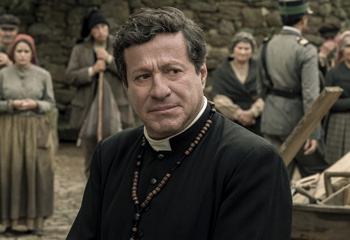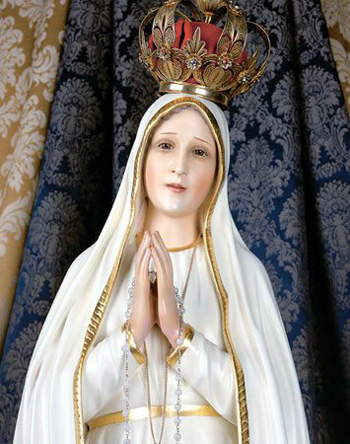Movie Review
 |
 |
 |
 |
 |
 |
 |
Distorting the Message of Fatima
to Fit Progressivism
Salwa Bachar

Not faithful to the real Fatima message or apparitions
Despite Pontecorvo’s assurance of accuracy, Fatima presents a blatantly incomplete and incorrect history of the apparitions of 1917 and subsequent messages to Sister Lucy. Incorrect in the sense that is contains disturbing omissions – particularly that of the Consecration of Russia, which still has not been made – & the addition of things that were never said or never happened in the Fatima story, all to cater to Progressivism.
Peace without conversion
Indeed, throughout the movie, there is no mention of the consecration of Russia, which was one of the main reasons that Our Lady of Fatima appeared to the shepherd children; she also called for conversion, omitted in the new supposedly comprehensive film.
Our Lady warned that if Russia were not consecrated as she requested, she would spread its errors throughout the world. As a matter of fact, Communism spread everywhere – I leave aside the errors of the cataleptical Russian Schismatic Church, incapable of any expansion and, actually, a puppet of Communism – Europe, Asia (especially China), Africa, Latin America and even North America in the 20th century. In the last 50 years much of Communism’s worldwide success is thanks to the propagation of Liberation Theology (Communism sprinkled with Holy Water) as well as the Conciliar Ostpolitik of the Vatican.
The world’s latest descent into totalitarian Coronavirus business lockdowns and house arrests and our country’s Antifa/BLM riots are a perfect expression of Communism’s infiltration into the United States. But in the mind of Fatima co-director Dick Lyles, Communism does not exist anymore because it fell into “demise” in the early 1990s after the collapse of the Berlin Wall (5:55 mark in this interview here).

The joviality of the movie characters contrast with the seriousness of the real children, below

Dick Lyles confirms this thinking: “We don’t need World War III to demonstrate that we can bring about peace, there’s plenty of opportunities for peace in our homes, our neighborhoods, our communities and in the nation, we just have to get people to focus on that, and say ‘it’s time that we all started becoming instruments of that peace,’ in the spirit of Fatima.”
Our Lady of Fatima promised peace, but with a condition: that the Pope in union with all the Bishops of the world consecrate Russia to her Immaculate Heart and its subsequent conversion. She did not promise “peace at all costs.”
True peace, as explained by Prof. Plinio Corrêa de Oliveira, is tranquility of order. Without order – without the Church and society perfectly ordered to God and the fulfillment of His commandments – there can be no true peace, no accord between good and evil, no Reign of Mary (the era of peace promised by Our Lady).
So, by suggesting that "peace and love" is the message of Fatima, the movie directors are promoting hippie ideals rather than the true intent of Our Lady's request for "consecration, penance and conversion"; it is a clear adulteration of her authentic message.
Examples of pacifism in the movie
This progressivist idea of peace-at-all-costs and tolerance for error is present throughout the film.
In one of the very first scenes, when Sister Lucy (the second one) is speaking to a fictional atheist journalist, she says, “I’ve always been fascinated by opinions opposed to my own.” Implicit behind this statement, which surely would never have been uttered by the real Sr. Lucy, seems to be an approval of religious pluralism – the idea that every religion pleases God – a basic tenet of Progressivism that is contrary to the Catholic Faith.

A progressivist parish priest who states: ‘knowledge means tolerance’
Later on, when the mayor forcibly removes Catholics from the local church, the parish priest gets into an argument with him. He reminds him that the mayor’s mother used to come to the church often, and the mayor tells him, “My mother was illiterate, unfortunately for you I’m not. I’m different.” The priest responds with the catch-phrase, "knowledge means tolerance!”
This discussion and its conclusion have a clear anti-clerical/Masonic tone. It is sad to see the directors using Fatima to spread these progressivist errors.
As Atila Guimarães noted in his Collection, the definition of the spirit of Vatican II is tolerance for error and evil. (1) Knowledge does not mean tolerance. True knowledge is knowledge of the Truth – Our Lord Jesus Christ is the Incarnate Wisdom – and this knowledge should bring a person to worship Him & obey Him. The love for truth must inevitably bring a total rejection of error and evil. There can be no “tolerance” or happy co-existence between Catholics and non-Catholics.
The idea of peace-at-all-costs is not only present in the movie’s earthly characters, but also in the words Our Lady speaks in the film. In the first apparition, Our Lady is depicted as saying: “The world needs peace.” In fact, what Our Lady said at the end of the First Apparition of May 13, 1917, was this: “Pray the rosary every day to obtain peace for the world and the end of the war.” Why do the directors take the liberty of changing the actual well-recorded facts of what Our Lady said in these important apparitions? Yet, they do this consistently, so the viewer who does not know the Fatima story receives a false idea of what was said there.
Later in the film, she says: “I will lead them to my Son through peace and love.” Our Lady never said such banal, throw-away phrases, but again, more catering to the progressivist agenda of pacifism and tolerance.
Inaccurate & inconvenient depictions of Our Lady

A strange new-age bleeding Mary contrasts violently with the depictions of Our Lady, as described by Lucy

In fact, during the second apparition of June 13, 1917, Our Lady opened her hands and the children saw themselves in it, "as if submerged in God." Lucy stated: "There was a Heart on the palm of the right hand of Our Lady, with thorns piercing It. We understood that this was the Immaculate Heart of Mary, so offended by the sins of mankind, desiring reparation.” (John de Marchi, The True Story of Fatima, 1947, p. 25).
In the accounts of the October apparition, Sister Lucy reported that Our Lady appeared in three different scenes in succession representing the Joyful, Sorrowful and Glorious mysteries of the Rosary. In the Sorrowful scene, she appeared dressed in purple as Our Lady of Sorrows and "without the sword in her breast." (Ibid., p. 56)
No blood or wounds were ever mentioned in any of the apparitions. What really happened is not what we see in this film.
Final thoughts & impressions
Added to all this is a triviality that is omnipresent in the film, seen in cheesy catch-phrases, sentimental music, frivolity and a lack of seriousness particularly on the part of the Fatima children, who are presented as semi-modern children, constantly smiling throughout the movie.
I would say that this Fatima movie is another tool for advancing the hippie "peace and love" agenda as well as progressivist religious indifferentism.

- The second part of the definition of the spirit of Vatican is: Hostility towards the militancy, hierarchy and sacrality of the Church. See Mr. Guimarães explain here.
Posted October 9, 2020
______________________
______________________





